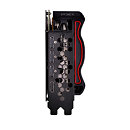Thursday, October 15th 2020

EVGA Releases Optional BIOS Update for RTX 3080 FTW3 ULTRA - XOC 450 W
EVGA has just released a shocking update for their RTX 3080 FTW3 Ultra graphics card, which increases the cards' power limit to 450 W, a 50 W increase over the 400 W power limit the card ships with. The BIOS release doesn't, however, guarantee higher performance - as always, NVIDIA's Boost is affected by temperatures (which are, in turn, affected by the chips' power draw). What this power limit increase does mean is that users who want to embark in overclocking feats can now do so with more ease.
The EVGA RTX 3080 FTW3 ULTRA thus joins ASUS' ROG STRIX OC in their upper power limits; NVIDIA's RTX 3080 cards are usually capped at 320 W or 340 W, due to power efficiency and temperature concerns. EVGA's FTW3 Ultra features three 8-pin connectors to allow for this amount of power to be delivered to the boards' circuits. Look after the break for the rundown on this BIOS availability by EVGA's own Jacob Freeman. The original post on EVGA's forums is available via the source link. After you do update the BIOS (if you choose to do it), you can use TechPowerUp's GPU-Z application to verify the changes to your cards' power limit.
Source:
EVGA Forums
The EVGA RTX 3080 FTW3 ULTRA thus joins ASUS' ROG STRIX OC in their upper power limits; NVIDIA's RTX 3080 cards are usually capped at 320 W or 340 W, due to power efficiency and temperature concerns. EVGA's FTW3 Ultra features three 8-pin connectors to allow for this amount of power to be delivered to the boards' circuits. Look after the break for the rundown on this BIOS availability by EVGA's own Jacob Freeman. The original post on EVGA's forums is available via the source link. After you do update the BIOS (if you choose to do it), you can use TechPowerUp's GPU-Z application to verify the changes to your cards' power limit.
Due to many users request, have a new BETA BIOS that increases the maximum Power Target. This BIOS is only intended for the extreme overclocking user and does not have any other changes. Please note the following:
This update will increase the power consumption while overclocking, and is recommended you have adequate cooling and power (850w+ Gold minimum) when using this.
EVGA does not guarantee any performance increase or overclock while using this BIOS update.
Any other questions or concerns will be answered in this forum thread only. Please post below your results and feedback!
BIOS Instructions (Windows Installation):
Download the correct.zip file below for your graphics card below.
Extract the files to a location on disk.
Make sure no programs are running in the background, and double click Update.exe
Press "Y" to begin the update.
DO NOT TURN OFF POWER OR RESET DURING THE UPDATE PROCESS!
After update, restart PC.
EVGA GeForce RTX 3080 FTW3 ULTRA
EVGA GeForce RTX 3080 FTW3 ULTRA - BIOS 1 (Normal) |BIOS 2 (OC)
NOTE: There are 2 BIOS's, one is for the BIOS when switched to the normal stock position, the other if switched to the OC position



29 Comments on EVGA Releases Optional BIOS Update for RTX 3080 FTW3 ULTRA - XOC 450 W
In Ampere all units can process FP but half of them can process Int. Turing had cuda cores only capable of FP, and other units (same amount) only capable of Int that are called... Int processing units, but not cuda cores.
Its the FP capability (do or dont) that defines a unit to be (called) cuda core or not.
Its Jensen on the work!
Only real life apps/games.
Marketing is marketing and their job is to throw out some numbers to impress. And its working, because the majority of people (maybe 90%) do not spend their time to be informed about the details or the actual performance.